Page 313 of 352 pages « First < 311 312 313 314 315 > Last »
Correspondence
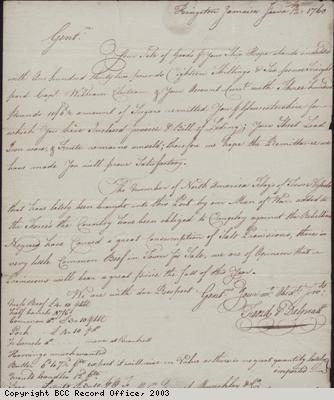
Description:
Letter from Jamaica to Samuel Munckley, regarding the slave rebellion, 1760.
Date: 1760
Copyright: Copyright BCC Record Office
Object ID:AC/MU1/11(h)
Letter regarding crop expected

Description:
Letter regarding expected crop from agents, 1798, Spring Plantation, Jamaica. The letter is addresssed,
For John Hugh Smyth…Ashton Court Near Bristol…
Creator: Spring Plantation
Date: 1798
Copyright: Copyright BCC Record Office
Object ID:AC/WO/16(27)174b
Assignment of slaves
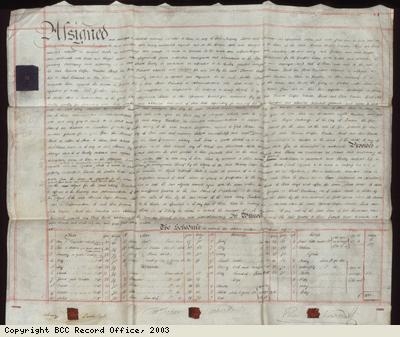
Description:
Assignment of slaves in Georgia.
Document showing the sale of slaves and their descendants in Georgia, 1805.
Date: c1805
Copyright: Copyright BCC Record Office
Object ID:8032/49
Illustrated page from a log book

Description:
Illustrated page from the log book of the slave ship the Lloyd 1771, from Bristol, captained by Nicholas Pocock. Pocock was an artist as well as a captain and drew these illustrations of the ship. This page shows differnt views of the ship and also records the weather that day. The log book was used by the captain to record the daily progress of the ship on its voyage.
Date: 1771-1772
Copyright: Copyright BCC Record Office
Object ID:38032
Bill for sale of slaves

Description:
Bill for sale of four slaves in South Carolina, for $1,390, in 1812. Purchased by T C Vanderhorst (who owned a plantation in the Americas and had Bristol links), from Thomas Greyson.
Creator: T C Vanderhorst
Date: 1810-1812
Copyright: Copyright BCC Record Office
Object ID:8032/52
Detail, assignment of slaves

Description:
Detail from a legal document about the sale of slaves and their descendants in Georgia, 1805. The 36 slaves were transferred from Mary Turnbull of London to Thomas Cooper Vander Horst of Hertfordshire and Elias Vander Horst of Bristol. The sale included all the Progeny, Issue and Increase [children] of the females of the said Negros or Slaves for the sum of £2,100.
The language used to describe people of African descent in the 18th, 19th and 20th centuries is unacceptable in today’s terms. We cannot avoid using this language in its original context. To change the words would impose 20th century attitudes on history.
Date: 1805
Copyright: Copyright BCC Record Office
Object ID:8032/49
Parliamentary reports
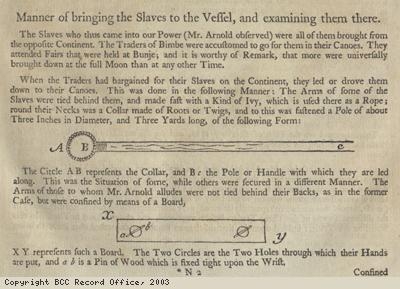
Description:
Lords Committee of Council reports, 1789. This page from a report shows a diagram of the shackles used on slaves.
The Lords Committee of Council was a Parliamentary Committee.
The title of the reports reads: Report of the Lords Committee of Council appointed for the consideration of all matters concerning the present state of the Trade to Africa and particularly the Trade in Slaves …
Date: 1789
Copyright: Copyright BCC Record Office
Object ID:08527
Extract from opera Inkle and Yarico
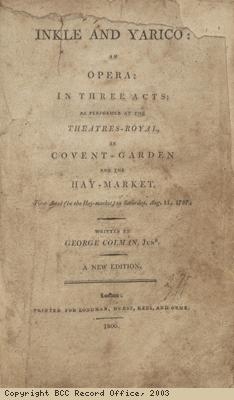
Description:
Extract from the prompt book for the comic opera, Inkle and Yarico, 1799.
An Indian woman is sold into slavery on Barbados by the man she had rescued and protected from her countrymen when he was shipwrecked. He then repented of his action towards the woman he had loved, redeemed her and married her.
Inkle and Yarico is a comic opera, which was written by George Colman the Younger in 1787.It is based on a supposedly true story told in Richard Ligons True and Exact History of the Island of Barbados.
A young man was shipwrecked on the South American coast and his life was saved by a young Indian woman.
He got off the island, taking her with him, and then sold her into slavery in Barbados.
This story was romanticised by Steele, writing in the Spectator in 1711.
Colman adapted Steeles story into his comic opera. It was very popular and was performed many times at different London theatres.
In Colmans version, Thomas Inkle, a young Englishman, is taking his fiance out to her father, the Governor of Barbados.
He is lost overboard with his servant and is marooned on an island.
They are saved from the cannibal locals by a young Indian woman, Yarico, and her servant.
Inkle and Yarico fall in love. Inkle and Yaricos servants also fall in love with eachother.
Inkle promises undying love to Yarico.
They are taken off the island by a British boat and taken to Barbados.
There, Inkle is reintroduced to civilised life and realises his position.
He applies economic theory rather than love to his situation, by choosing his fiance and selling Yarico as a slave.
His servant refuses to sell his Indian lover as a slave.
Inkle is then humiliated for his ingratatitude and betrayal of Yarico, repents his behaviour and marries her.
This story was romanticised by Steele, writing in the Spectator in 1711.
Colman adapted Steeles story into his comic opera. It was very popular and was performed many times at different London theatres.
In Colmans version, Thomas Inkle, a young Englishman, is taking his fiance out to her father, the Governor of Barbados.
He is lost overboard with his servant and is marooned on an island.
They are saved from the cannibal locals by a young Indian woman, Yarico, and her servant.
Inkle and Yarico fall in love. Inkle and Yaricos servants also fall in love with eachother.
Inkle promises undying love to Yarico.
They are taken off the island by a British boat and taken to Barbados.
There, Inkle is reintroduced to civilised life and realises his position.
He applies economic theory rather than love to his situation, by choosing his fiance and selling Yarico as a slave.
His servant refuses to sell his Indian lover as a slave.
Inkle is then humiliated for his ingratatitude and betrayal of Yarico, repents his behaviour and marries her.
Date: 1799
Copyright: Copyright BCC Record Office
Object ID:8979/11
Anti-slavery newspaper (detail)

Description:
Detail from a New York newspaper against slavery, part of a collection made by Mr. Estlin from Bristol, who campaigned against slavery. The detail explains how not enough was done by the fair ladies of England and the United States to abolish slavery.
THE LADIES OF ENGLAND AND THE LADIES OF AMERICA ON THE QUESTION OF SLAVERY.
GEORGE CANNING, at the close of the long French war, said, the next war will be one of principle.We have an illustration of this prophecy before us.
A war has broken out between the fair ladies of England and of the United States, on the question of Slavery. It is not, however, a combat with deadly weapons, which two nations of Amazons would resort to, but is confined to weapons of a peaceful character, though often sharply pointed, such as becomes the enlightened of the nineteenth century. But it is to all intents and purposes a war of principle. An Address from the Ladies of England, headed by the Duchess of Sutherland, and others of high rank, was forwarded to America, entreating their fair sisters to interfere in behalf of the slave. The address was couched in terms most respectful, and almost humble, and in our judgement it did not go far enough. It did not ask their influence to abolish Slavery, but only to abolish some of the abominations of a system which itself is one unmitigated abomination. It prayed the dames of Virginia and Georgia to allow their poor slaves to be educated and taught the knowledge of Christianity and that the sacredness of the marriage laws might be preserved….
Date: unknown
Copyright: Copyright BCC Record Office
Object ID:17562/2b
Ellen Craft, an escaped slave
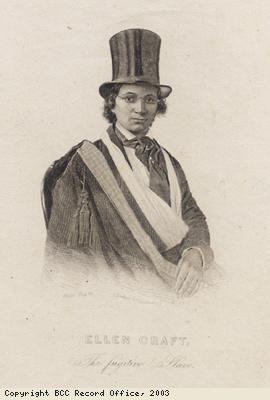
Description:
Illustration from the extract book of poet Mary Carpenter,1836. The illustration is of Ellen Craft, a famous slave who escaped from her owner by dressing as a white man.
Creator: Mary Carpenter
Date: 1836
Copyright: Copyright BCC Record Office
Object ID:12693/20
Page 313 of 352 pages « First < 311 312 313 314 315 > Last »

